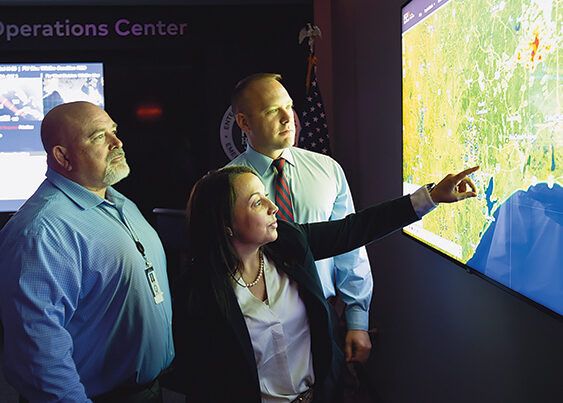In a time when global catastrophes have a local impact, HCA Healthcare’s approach is simple: Be ready
Until a few years ago, hospitals planned and trained for potential crises with the perspective that most of the imaginary situations known as never-events, such as a mass casualty from domestic terrorism, repeated hurricanes each season, hazardous-materials incidents with community impact or a global pandemic, wouldn’t ever happen. But in 2022, after more than two years of enduring an all-encompassing global health crisis that has led to a high death toll, staffing shortages and financial fallouts, we’re living in a time when never-events are a common occurrence.

“With the way the world has changed with greater community risks, things are getting much more challenging,” says Michael Wargo, RN, BSN, MBA, PHRN, VP and Chief of Enterprise Emergency Operations and Medical Transport, HCA Healthcare. Wargo leads the emergency readiness and response operations for the healthcare system’s 182 hospitals and approximately 2,300 care sites. “Now, never-events are often daily events,” he adds.
Poised to respond
Every hospital and health system has its own unique set of challenges and community-based threats, but some disasters could happen anywhere—from the effects of climate change to mass shooting tragedies. “We know the climate is changing because we are experiencing natural disasters with higher frequency and intensity,” says Wargo. “We need to plan for a shooting because we don’t know when or where it could happen. It’s a risk we not only need to be prepared for, but we need to be ready to respond at a moment’s notice.”
That means hospital staff must be trained, educated and equipped at all times. In turn, leaders must change their mindset and organizational culture to operate under the assumption that on any given day, a crisis of various proportions will likely happen in one of our communities.
From an emergency operations standpoint, Wargo’s team is in full-time readiness mode, which means monitoring situations daily from their command center. “I can tell you that today, for example, we have severe storms coming across from California through Tennessee, which are a big concern for us,” shared Wargo one weekday in early April. “Well over 100 tornadoes touched down in the middle of the U.S. in the past week with fatalities and destruction. Our goal is to ensure continuity of care for our patients, safety for our staff and families, and support to the communities we are part of.”
Wargo and his team anticipate a busy hurricane season this year, so they’re preparing their facilities and staff, based on the protocols and best practices they’ve developed through their finely tuned emergency operations plan. Those best practices have been carefully developed based on these must-do steps for health systems of any size:
- Perform risk assessments. Hospitals and organizations must conduct objective risk assessments. That means looking at internal vulnerabilities and third-party systems that are relied upon to provide patient care and core business operations. “The vulnerabilities that are missed in risk assessment reviews often end up being what takes down systems and inhibits the ability to care for patients,” says Wargo.
- Establish playbooks & partnerships. Healthcare systems and supply chain partners must have a governance structure and operating system that ensures preparedness and emergency operations. It is important to have people on staff who understand the risks, develop playbooks to respond and recover from events, and have broad community partnerships and government agencies who can collaborate in a crisis.
- Conduct exercises. In January 2020, Wargo’s department received the first indication of a novel virus in China, later identified as COVID-19. “We ran a global pandemic scenario at the enterprise-level,” he explains. That afternoon, they ran the same exercise with HealthTrust executives, focusing on global supply chain impacts from a pandemic. “We asked questions like, ‘How will you manage this at scale? How will it impact the supply chain as a health sector?’ Having a team of dedicated leaders who understand risk and can give people real-world information to be prepared is critical.”
- Keep staff safety & mental health in mind. Making staff members’ home readiness a part of the emergency response equation is important because it gives employees peace of mind to do their jobs knowing their family is prepared and safe. For example, providing a healthcare worker a place to stay at the hospital if their family relocates to a safer place can provide much-needed solace. “The thinking is, ‘If my family is safe, then I can commit my time to care for patients,’ in a global pandemic scenario,” says Wargo. “Our operation goes above and beyond so that staff can be here when our patients need it most.”
In 2017, Hurricane Harvey ripped through Louisiana and Texas, causing catastrophic flooding and 100 deaths. “It was such a major event causing post-traumatic stress for many directly involved,” says Wargo. For days, the storm hovered. For staff, threats of the levees breaking and the stressors of their family’s safety were very real. “That’s something we have to prepare for. It’s difficult, but you can’t avoid the psychological stress endured by our staff and communities.”
The value of practice
Weeks before the COVID outbreaks in the U.S., HCA Healthcare exercised its online emergency operations system with its nearly 200 hospitals, mimicking an outbreak that led to a global pandemic.

After the drill ended, the Emergency Operations team asked participants for feedback. Some people responded that the scenario would never happen and questioned whether the drill was a good use of everyone’s time. “As the team running the exercise, we knew that the pandemic was developing and, in fact, was about to happen, but it was a balance between being an alarmist and providing information so that people could digest it,” says Wargo.
It is vital for professionals to escalate information at the right pace to ensure hospitals prepare, leaders engage and the culture changes over time—whether for a gradually-evolving crisis like a pandemic or a rapid-onset catastrophe like a mass shooting. “It’s human nature to be in shock, potentially go into denial and not take the appropriate action because you don’t believe the ‘never-event’ is actually happening,” adds Wargo.
Wargo’s team recently conducted an exercise involving radiation exposure. “We ran the HCA UK clinical leadership group in London through a scenario where a Ukrainian refugee enters the hospital as a transfer with gastrointestinal illness, which could be a sign of radiation illness,” says Wargo. The experience taught the UK team to have a higher index of suspicion for radiation sickness given this unique risk in their region. “The leaders who thought we were a bit crazy in our planning pre-pandemic said they would take our advice without hesitation and prepare differently this time,” Wargo notes. By equipping people with the right amount of information at the right time, they helped adjust the staff’s thinking and enhanced their readiness.
The domino effect of a crisis from afar
The COVID-19 pandemic was a quick lesson in how a global emergency can have immediate and long-lasting effects on the supply chain and stress the interdependencies between sectors. Beyond preparing for disasters close to home, a good emergency plan considers how a health system’s operations rely on stability around the world, be it supply chain, communication systems or transportation. We are not operating healthcare alone—we are part of a global cross-sector operation.
While a geopolitical event like Russia’s war on Ukraine seems distant, it does not make the U.S. immune from the situation. “What we’re not exempt from is the collateral impact, and that is our supply chain or the care of refugees that have migrated to our communities for safety,” says Wargo. “It’s important to understand the war is challenging us as much, if not more, than the pandemic in various ways.”
Raw materials are sourced from around the world, including Ukraine. Shortages of raw materials can disrupt the supply of surgical devices and pharmaceutical manufacturing, which, in turn, disrupts services that hospitals can provide. “As an individual entity, hospitals might feel a greater impact by the pressure of a single surgical device not being available, but as a national health system we might not feel such pressures given our ability to share resources in current stock. Globally, the broader impact may cause patients to have to wait for needed surgeries, such as orthopedic joint replacements,” says Wargo. “Even when the war ends, the question becomes whether they will have people to do the work in the regions directly impacted by the conflict. Likely not.”
Cybercrime, often committed beyond our country’s borders, poses another potential threat with ripple effects for hospitals and the entire healthcare sector. “Cybersecurity is a significant threat to all of us professionally and personally,” says Wargo. “We can prepare for cyber breaches, but what if the criminals take down an organization’s ability to order product from distributors and manufacturers because their systems are compromised?” Healthcare systems, the supply chain and critical infrastructure sectors all must ensure high levels of protection against cybercrime. (See related article, “Cyber Aware.”)
Building a resilient healthcare system
A mission of readiness is about ensuring a more resilient healthcare system. During those two years of the pandemic, communities around the country were also hit by hurricanes, domestic terrorism, mass shootings and other crises. Resilience allows us to adjust our mindset and resources in response to additional disasters and incidents, all while persevering through something like a pandemic at a marathon pace.
“Being resilient means getting through this together and still having the ability to care for our patients and continuing business operations,” adds Wargo. “Our mission is to be there for our patients no matter what. Whether we go through a pandemic, a natural disaster or another event, we must rely on each other as a healthcare sector.”
Share Email Disaster & Emergency Preparedness, Operations, Q3 2022, Staffing




